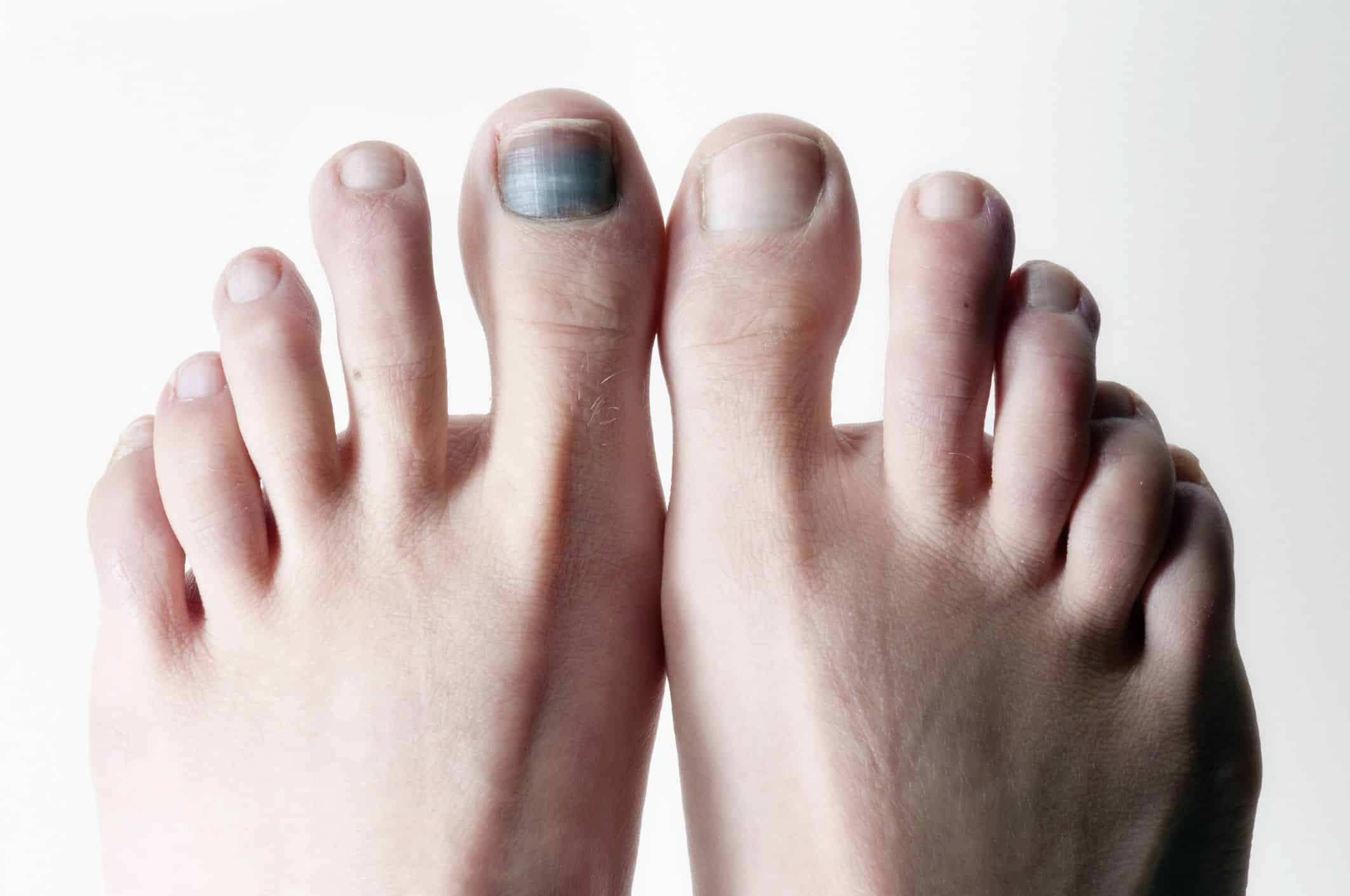Black toenail cancer is the same sort of cancer (melanoma) found on any part of your body, except that they have grown under your nail. Black toenail cancer is also known as subungal melanoma. The term “subungal” simply means “under the nail”.
If you’ve been wearing nail polish for many years or not taken too much care of your feet, you may have completely missed such a symptom.
Black toenails can be uncomfortable and unsightly at times. Although black toenails may have many potential causes, many are easy to treat or may clear up on their own.

Health Professionals frequently see patients obsessed about a black spot that appeared under their nails. While it may be an indication of Black toenail cancer, this symptom is present in many other conditions. If you’re concerned about a black spot under your toenail, keep this information in mind and schedule an appointment immediately with your doctor.
Recommended: Can You Treat Toenail Fungus While Pregnant?
What Are The Possible Causes Of Black Toenail Cancer?
The Possible causes of black toenail cancer are:
- UV Light: Many melanomas are associated with skin cancer and can, therefore, be attributed to spending too much time in the sun or not using sun creams properly or at all. But, there is no conclusive explanation as to why it may occur. Many doctors think that damage to the toe or nail may cause them.
- Melanoma: For rare cases, melanoma, the most aggressive form of skin cancer, may cause black toenail cancer. Melanoma causes one or more dark, irregular-looking skin patches to form in the skin. The darkening skin patch grows under the nail bed in some cases. Melanoma progresses gradually and without other symptoms, so in the early stages, it is often not detected, particularly when it originates under the toenail.
- Trauma: When a person wears poorly fitted shoes, due to repetitive trauma, they may be at risk of developing black toenail cancer. Long-term pressure from poorly fitting shoes on the toes can cause a range of problems, ranging from small blisters to under the nail bloody blisters. In mild cases, without treatment, the black toenail will grow naturally over time. An individual must seek medical treatment in severe cases, such as when the nail starts to detach from the nail bed.
- Underlying diseased conditions: Some medical conditions can cause black toenail cancer. These conditions include diabetes, kidney disease, anaemia and heart diseases. In most cases, treating the underlying condition can help stop or regress the melanoma growth and the nail will regain its original colour later.
What Are The Symptoms Of Black Toenail Cancer?
When a small, dark spot can be seen under the toenail, it is the most common symptom of this type of cancer (Black toenail cancer). For a normal mole, you may mistake this as they look very similar. These can be a bruise-like red, dark brown, black, or even green.
Read Also: Best Portable Nail Drills: Top 10 Picks
One common symptom is where you have a dark line stretching from the nail tip to the cuticula. This is also referred to as Hutchinson’s sign.
Symptoms of black toenail cancer are:
- Darkening skin close to the toenail
- cracking or breaking nails
- Bump developing on nails
- A nail that bleeds without any trauma
- any mark or spot on the nail that keeps increasing in size
- Bruise on the nail without any cause
The melanoma spot has no noticeable colour at all in a small number of cases, making it difficult to see. Sadly, these are often not identified as soon as possible and if they are malignant growths can be severe.
Black Toenail Cancer Treatment
Unfortunately, removal of part or whole of the toenail remains the best treatment option for Black toenail cancer. Those are potential tumors, but they are also benign, which means they can be removed with surgery very quickly and easily.
The operation will only last for around an hour and will be performed under local aesthetics, which ensures that a lengthy hospital stay is impossible if complications arise from the procedure.
If there is cancer, chemotherapy or radiotherapy may be followed up by the doctor.
What Is Black Toenail Fungus?
Black toenail fungus is one of the most common toenail issues experienced, usually by athletes running, skating, or using their feet during sporting activities. Because of the humidity in their socks and toenails, which is the perfect breeding ground for growing microorganisms. These microorganisms can develop into black toenail fungus and ingrown nails. Another cause of black toenails is blood under the nail when a toe is hit or rubbed against a shoe’s tip for a longer period of time.
Read Also: Pneumonia In Elderly: Causes, Treatment, And Recovery
These microorganisms can take up to 2 weeks to notice any changes, such as discoloration or black toenails. With the appearance of black toenail fungus, it can be embarrassing to wear sandals or flip flops.
Black toenail fungus could be the reason why it was easy to turn your nails black, brown, brittle, and chip. You can get rid of toenail fungus in many ways by using topical solutions and creams recommended over the counter by your doctor, which should penetrate the deep layer of the skin when applied to the area.
It is important not to overlook the presence of a black toenail fungus, particularly in people with diabetes, which could turn into a fungal infection. To order to evaluate the disease, it is best to be treated by a doctor and if you neglect this disorder, it may turn out to be something severe that could lead to loss of nail or extremity.
Antibiotics are needed in cases where the infection causes the skin to be sore or grow ulcers under the plate of the nails. Diabetics have a harder time recovering from wounds and that’s why you should consult your doctor in those cases.
Recommended: Toenail Growing Under Toenail: All You Need To Know
Black Toenail And Diabetes
Diabetes can, over time, cause nerve damage, also known as diabetic neuropathy, which can cause tingling and discomfort, and may cause you to lose your feet. You may not notice a pebble inside your socket or a blister on your foot if you lose feeling in your feet, which may lead to cuts, sores, and black toenail cancer. These cuts and sores can get infected.

The fact is that many people grow toenail fungus or onychomycosis, but in people with diabetes, it is about twice as common. Diabetic nerve damage in the feet that can prevent a person from recognizing toenail damage and decreased circulation that prevents healing are both partly responsible for this increased risk.
You probably already know how important it is to inspect your feet daily in search of red spots, blisters, sores, or other irritations. If they are left alone for a very long time, these can become life-threatening.
Getting to a podiatrist or foot specialist regularly is the first step to take good care of your feet. You can visit him for a foot check-up at least once a year. A doctor will look for toenail fungus symptoms and will advise you about the best ways to treat it.
Read Also: Can a Nail Grow Under Another Nail?
Because you have diabetes, toenail fungus treatment will be a bit different, and maybe even more aggressive.
Black Toenail From Running
You may find a toenail turning black, blue, or grey at the end of a long walk or run, and it may be swollen under the nail. Because of bleeding under your skin, which is also known as a subungual hematoma, you get a black toenail. When you drop something on your toe or smash your toe against an obstacle, this can also happen.
The foot slips forward in the shoe as you walk or run, bashing your toes with each step against the top, middle, and sides. While walking or running, your feet also swell and get compressed with your socks and shoes. That pressure and impact can damage your toenail beds, or under the toenail itself create a blister. When this occurs, the toenail is removed from the toenail bed by the extra blood and water. During the healing process, the blood colours toenail black and the toenail would probably continue to change colours.
There is no need to drain an uneducated and painful black toenail. If the issue is merely a pool of blood under the nail and it continues to rise and swell, then a doctor will relieve the pressure by digging a hole in the nail, called a trephination procedure. Even though a specialist is preferred to do this, it is something most people do themselves at home. If you have diabetes, instead of removing it at home, you need to seek medical assistance as an infection can have serious consequences.
Toenail Discolouration
Nail discolouration can result from various skin infections and conditions in which the nails appear white, yellow, or green. Discoloured nails are the result of infections with common fungi found in water, dirt, and soil in about 50 percent of cases. Nails can be infected by many types of fungi. Nevertheless, the Trichophyton rubrum is by far the most common. A form of fungus appears to invade the body, so it is known as a dermatophyte.
Read Also: 5 Best Mouthwash For Foot Soak
Pseudomonas is a type of bacteria that infects the nail bed, resulting in the nails being greenish in colour. Red or black (which may sometimes appear bruised) nails may result from trauma (including grown toenails) caused by a hematoma (a collection of blood) under the nail.
Chronic medical problems can also affect the nail’s appearance. Diabetes or liver, kidney, lungs, or lung disorders may be indicative of specific colour changes in the nails. This is why, during a routine physical examination, doctors pay special attention to the feet.
Brown Toenail
The medical term for toenail discoloration e.g brown toenail is Onychomycosis. Brown usually appears to go up and down the nail as a line or streak. Possible causes of brown toenail are; injury, melanoma, inflammatory conditions, fungal infections and some medications.
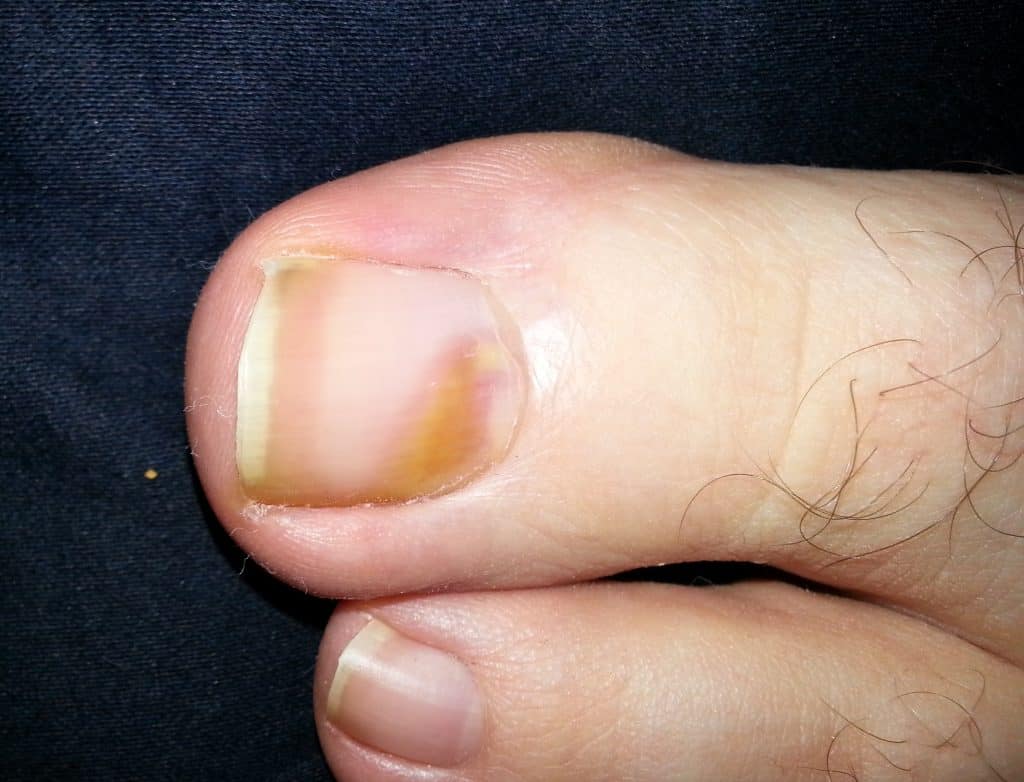
Because your brown toenail streak has a small chance of being a sign of something serious, playing it safe and getting it checked out by your doctor is paramount.
How To Get Rid Of Brown Toenails
You may take steps to manage the disorder and prevent it from happening in the future.
Use soap to wash your feet. Make sure to clean and wash the gaps between the toes as well. Rinse it well. Spray the feet dry with a clean towel, including the gaps between the toes. The spaces between the toes are where the foot is usually sweating, so you need to keep them clean and dry. Fungus is fond of an anaerobic environment.
Short clip of your toenails. Cut the nails straight and avoid deep cutting into the toenails ‘ sides. This will prevent injury or ingrown nails from occurring.
Smooth the affected toenails with tea tree oil. You can also apply it to all your toenails to ensure that the champignon is eliminated. Use the oil every four or five hours. The brown nails can also be treated with lavender oil, olive oil, or oregano oil.
Zetaclear is sometimes used as a treatment for treating nail fungus and it’s really good. It is a mixture of oil from the tea tree and other oils.
Wear open-toe sandals at home to allow fresh air to get rid of the champignon. However, when you go out, make sure your feet are covered in the outside environment to protect them from the dirt and microbes.
Read Also: Can I Use Baking Soda On My Dog For Itching?
Staying at home while treating brown toenails is the best way to keep your feet as clean as possible.
Wash your feet every time they get dirty to avoid fungus, especially the toenails.
If, despite this remedy, the brown toenails spread to other toes, consult a doctor.
Products That Can Treat Black Toenail and Fingernail
Below are some tested and trusted products that can help treat your black toenail as well as your black fingernail. These good products include:
- Ariella Nail Fungus Treatment
- Kerasal Fungal Nail Renewal
- Foot Cure Extra Strong Nail & Toe Fungus Treatment
- Maximum Repair Nail Solution
- 3in1 Toe and Nail Fungal Repair
White Toenail Nail
Toe trauma can also cause a white streak — even if you may not know that you are hurting yourself. It can occur, for example, when shoes are too small and the toe hits the shoe’s side.
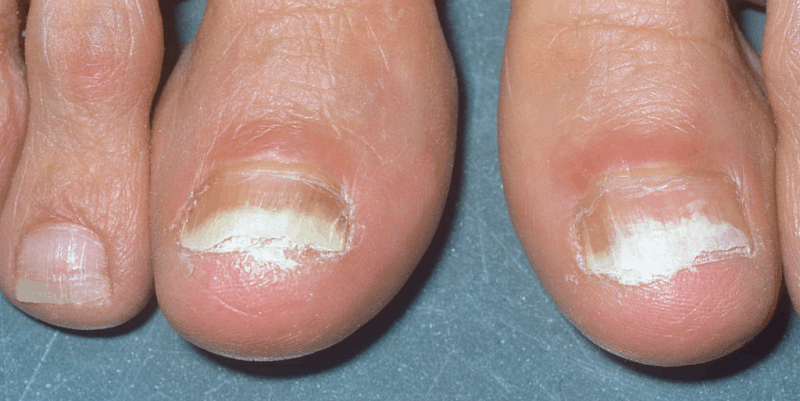
Do you have a white toenail, or do you have large patches of powder? You might have a fungal infection called white superficial onychomycosis, most likely. See a doctor as soon as you discover this, if possible. This disease is transmitted through the toenail. White superficial onychomycosis can make rough and crumbly the entire tooth.
Read Also: Eczema Removal Tips, Signs, Symptoms, Causes and Prevention
Proximal subungual onychomycosis is another type of fungal infection. It looks like a whitish or yellowish patch that begins near the cuticle at the base of the toenail. In healthy people, the infection is rare. This happens more frequently in people with weakened immune systems. It can be a sign of HIV as well.
White toenails are indicative of liver disease and diabetes.
How To Get Rid Of White Toenails
In superficial onychomycosis, the white patches of the fungus forming on the nails can sometimes be simply removed by filing it off.
An over-the-counter antifungal topical medication like Terbinafine or fluconazole can be applied to the nail to kill the fungus.
Traditionally, oral prescription antifungals such as terbinafine (Lamisil) and fluconazole (Diflucan) are used to treat toenail champignons. Such medications are often successful but can cause serious side effects ranging from stomach upset and dizziness to extreme skin and jaundice problems.
Treating any underlying medical condition such as diabetes or liver disease is another treatment option.
Doctors most often first prescribe terbinafine (Lamisil). Itraconazole (Sporanox) is a commonly used alternative, but it can cause serious interactions with drugs.
In very severe cases, it may be necessary to remove the entire nail surgically when toenail fungus is resistant to treatment.
Products That Can Treat White Toenail and Fingernail
Below are some tested and trusted products that can help treat your white toenail as well as your white fingernail. These good products include:
- Opti-Nail Fungal Nail Repair Pen
- Probelle Natural Fungal Nail Treatment
- Kerasal Multipurpose Nail Repair
- Arishine Fungus Treatment
- Nail and Toe Fungus Treatment
White Marks On Toenail
Leukonychia is a condition that appears on your finger or toenails with white lines or dots. This is a very common and harmless issue. The spots may affect one or more nails. Leukonychia is most commonly caused by damage to the nail bed.
Blue Toenail
A blue tinge can be quite alarming to your toenails, but this can have many different causes. If you’ve had a lot of running or injury to the area, this could be the underlying cause of the blue toenails. If the blue tinge is not noticeable, you may want to seek medical help.
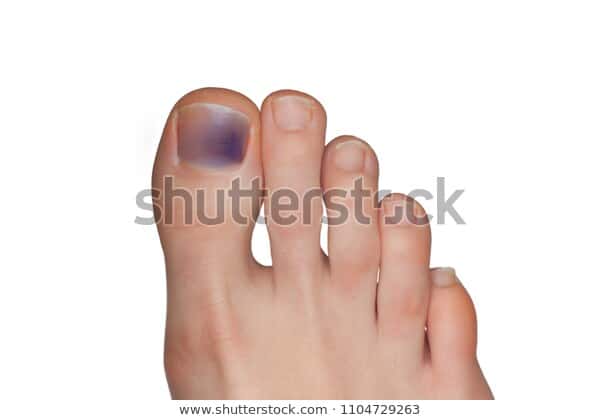
Other potential causes of blue toenails exist. In some cases, poor circulation in the body causes black toenails. If the blood flow is restricted, the nail may become discoloured.
Read Also: Broken Nose First Aid Treatment
In general, if you have other symptoms, including numbness in the affected area, shortness of breath and dizziness, it is important to seek medical advice.
Anaemia is another possible disorder that can cause blue toenails, as with this disease, oxygen supply is more limited. Certain potential disorders include heart disease and asthma.
Green Toenail
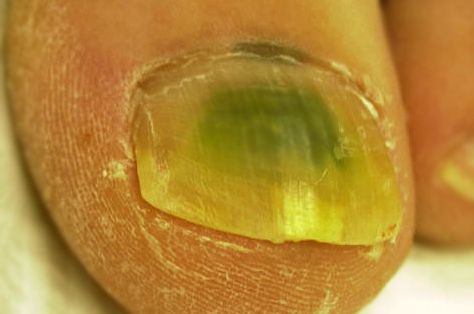
This is a shade you don’t want to see on your toenails when you are not wearing green nail polish. It might be a condition of green-nail called chloronychia, caused by an infection. Bacteria which grow in warm and wet conditions are typically the culprit. Think of hot tubs, sponges, and comfortable boots you’ve been wearing for a long time. The colour is below the hair, so try not to wash it off. Instead, visit your doctor.
